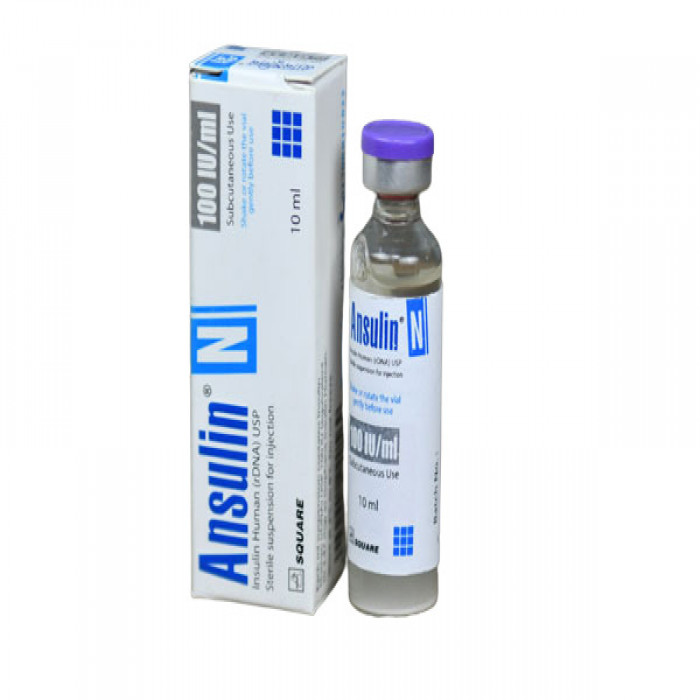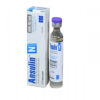Ansulin N 100IU Vial
385.95৳
Generic: Insulin (Human) N 100 IU/ml
Type: Injection
Pack Size: 10ml
Description:
Indication
Diabetes mellitus
Administration
Administer within 15 minutes before a meal or immediately after a meal. Administer subcutaneously in the upper arm, thigh or abdominal wall. A subcutaneous injection into the abdominal wall results in a faster absorption than from other injection sites. NPH Insulin suspensions are never to be administered intravenously.
Adult Dose
Subcutaneous Type 1 Diabetes Mellitus Suggested guidelines for beginning dose Usual daily maintenance range is 0.5-1 unit/kg/day SC in divided doses; nonobese may require 0.4-0.6 unit/kg/day; obese may require 0.8-1.2 units/kg/day Type 2 Diabetes Mellitus Adult: Usual insulin requirement: 0.3-0.6 IU/kg/day; may be given in 1-2 divided doses. Dose should be individualised, to be adjusted according to patient’s needs. Suggested guidelines for beginning dose: 0.2 unit/kg/day May be used alone or in combination with a fast-acting insulin. Change insulin doses in small increments: Type 1 diabetes (2 unit change); type 2 diabetes (2-4 unit change). Look for consistent pattern in blood sugars for >3 days When combined with regular insulin: Morning Give two thirds of daily insulin SC Ratio of regular insulin to NPH insulin 1:2 Evening Give one third of daily insulin SC Ratio of regular insulin to NPH insulin 1:1 Dosing Considerations Dosage of human insulin, must be based on the results of blood and urine glucose tests and must be carefully individualized to optimal effect Dose adjustments should be based on regular blood glucose testing Adjust to achieve appropriate glucose control Hepatic impairment: Dosage reduction may be needed.
Child Dose
Type 1 Diabetes Mellitus <12 years: Safety and efficacy not established >12 years: Suggested dose is 0.5-1 unit/kg/day SC; use adult dosing; usual daily maintenance range in adolescents is <1.2 units/kg/day during growth spurts
Renal Dose
Renal impairment: Dose adjustments may be needed.
Contraindication
Hypoglycaemia. Hypersensitivity to any of the components.
Mode of Action
Insulin lowers blood glucose levels. It regulates carbohydrate, protein and fat metabolism by inhibiting hepatic glucose production and lipolysis, and enhancing peripheral glucose disposal. The various insulin formulations are classified according to their durations of action after SC Inj. They are divided into short-, intermediate-, or long-acting insulin. Soluble insulin (also known as ‘neutral insulin’ or ‘regular insulin’) is a short-acting preparation. To extend the duration of action of insulin, preparations are formulated as suspensions in 2 methods. The 1st method involves complexing insulin with a protein so that it is slowly released, e.g. protamine zinc insulin (contains an excess of protamine) and isophane insulin (or NPH insulin which contains equal amounts of protamine and insulin). An alternative method is particle size modification e.g. insulin zinc suspensions. While all the formulations can be admin by SC inj, most by IM inj, only soluble insulin can be admin by IV. Compared to SC inj, IM admin usually has a faster onset of action, with a shorter duration of action.
Precaution
Pregnancy (insulin requirements tend to fall during the 1st trimester, increase during the 2nd and 3rd) and lactation. Caution with decreased insulin requirements: Diarrhea, nausea/vomiting, malabsorption, hypothyroidism, renal impairment, hepatic impairment Hypokalemia may occur Not for IV or IM administration Use with caution in renal and hepatic impairment (dosage requirements may be reduced) Caution with increased insulin requirements: Fever, hyperthyroidism, trauma, infection, surgery Lactation: Safe to use while breastfeeding
Side Effect
Allergic reactions. Injection site reaction, lipodystrophy, pruritus, rash, lipoatrophy, hypokalaemia, blurred vision. Hypoglycaemia, insulin resistance
Interaction
Possible absence of hypoglycaemic warning symptoms with beta-blockers. Decreased hypoglycaemic effect with corticosteroids, danazol, diazoxide, diuretics, glucagon, isoniazid, phenothiazine derivatives, somatropin, sympathomimetic agents, thyroid hormones, oestrogens, progestins (e.g. in oral contraceptives), protease inhibitors and atypical antipsychotic (e.g. olanzapine and clozapine). Increased hypoglycaemic effect with oral antidiabetic agents, ACE inhibitors, disopyramide, fibrates, fluoxetine, MAOIs, pentoxifylline, propoxyphene, salicylates and sulfonamide antibiotics. Decreased insulin resistance with octreotide and lanreotide. Increased risk of wt gain and peripheral oedema with pioglitazone, rosiglitazone. Decreased effect of sermorelin.







Reviews
There are no reviews yet.